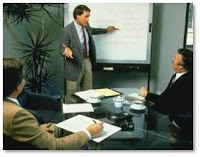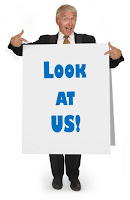 Clients hire you because they have needs. To provide great service, you must accurately understand your client's needs. So how would you rate your skill in uncovering needs?
Clients hire you because they have needs. To provide great service, you must accurately understand your client's needs. So how would you rate your skill in uncovering needs?
 Clients hire you because they have needs. To provide great service, you must accurately understand your client's needs. So how would you rate your skill in uncovering needs?
Clients hire you because they have needs. To provide great service, you must accurately understand your client's needs. So how would you rate your skill in uncovering needs?
 The rock bottom of low achievement or hard times, it seems, is to end up "flipping burgers at McDonald's." Similarly, we sometimes evoke the fast food giant's name as symbolic of low-price, low-value business--that is, the antithesis of what we aspire to in the A/E profession.
The rock bottom of low achievement or hard times, it seems, is to end up "flipping burgers at McDonald's." Similarly, we sometimes evoke the fast food giant's name as symbolic of low-price, low-value business--that is, the antithesis of what we aspire to in the A/E profession.  I spent most of last week helping an engineering firm prepare for an important shortlist interview. While each interview is different, there are some common themes in my approach. Some of my advice seems to diverge from the conventional wisdom in our industry. Yet I've enjoyed good success and my discussions with clients have validated my ideas about the process. So I'm devoting this post to sharing some of what I've found works:
I spent most of last week helping an engineering firm prepare for an important shortlist interview. While each interview is different, there are some common themes in my approach. Some of my advice seems to diverge from the conventional wisdom in our industry. Yet I've enjoyed good success and my discussions with clients have validated my ideas about the process. So I'm devoting this post to sharing some of what I've found works: I admit it; I'm cheap. I drive a car with almost 200,000 miles on it. I frequently eat at Subway when I'm traveling. I actually buy clothes on occasion at Walmart!
I admit it; I'm cheap. I drive a car with almost 200,000 miles on it. I frequently eat at Subway when I'm traveling. I actually buy clothes on occasion at Walmart! Mired in a recession, A/E firm leaders have renewed their interest in the topic of differentiation. Two years ago, the industry was on a roll. Most firms were doing quite well without being distinct from their competitors in any meaningful way. Now facing the prospect of a long, slow recovery, the need to be different seems more compelling.
Mired in a recession, A/E firm leaders have renewed their interest in the topic of differentiation. Two years ago, the industry was on a roll. Most firms were doing quite well without being distinct from their competitors in any meaningful way. Now facing the prospect of a long, slow recovery, the need to be different seems more compelling. Among the challenges facing those in management roles, perhaps none is so daunting as the lack of adequate time to do all that needs to be done. Nor is there a challenge that is so overlooked when it comes to management attention.
Among the challenges facing those in management roles, perhaps none is so daunting as the lack of adequate time to do all that needs to be done. Nor is there a challenge that is so overlooked when it comes to management attention. The Pareto Principle is evident among most A/E firms, with roughly 80% of their revenues coming from 20% (or less) of their clients. Obviously these few client relationships are critically important to the well-being of our firms. Yet relatively few firms have adopted a key account management approach.
The Pareto Principle is evident among most A/E firms, with roughly 80% of their revenues coming from 20% (or less) of their clients. Obviously these few client relationships are critically important to the well-being of our firms. Yet relatively few firms have adopted a key account management approach.2. Assess the Relationship
3. Evaluate our Positioning
4. Define our Strategy
Give top priority to improving service to your key clients. There's a tendency sometimes to take our best clients for granted. We work hard to win new clients and address problems with existing clients. But when things seem to be going well with our top clients, we may not give them the attention they deserve. Don't let your guard down! There's always someone trying to displace you, and they may be providing that next level of service and attention. Never be satisfied with the status quo.
Be sure you're getting regular feedback. Only about one-fourth of A/E firms formally gather feedback from clients. Feedback is the bedrock of great service. You can't be sure you're serving your clients well if you don't ask. Certainly, you want to be certain that your top clients are fully satisfied with your performance and service. For more insight into how to do this, check out this earlier post.
Become a trusted advisor and valued resource. In their book Clients for Life, authors Sheth and Sobel describe the path from "expert for hire" to "steady supplier" to "trusted advisor." Obviously the latter is the more secure position. Many firms serve only as a steady supplier even for their top clients. That leaves them vulnerable to being displaced. Trusted advisors are indispensable. They provide valued insight, not just expertise. They work collaboratively with the client, not just perform tasks. Are you a trusted advisor with your top clients? If not, determine what you need to do to become one.
 A minority of A/E firms regularly do strategic planning. A much smaller minority actually execute their strategic plans. Why do firms struggle so with follow-through? There are multiple reasons, but in my mind the main problem is firm leaders who are too busy and too distracted to adequately focus on strategic efforts.
A minority of A/E firms regularly do strategic planning. A much smaller minority actually execute their strategic plans. Why do firms struggle so with follow-through? There are multiple reasons, but in my mind the main problem is firm leaders who are too busy and too distracted to adequately focus on strategic efforts.Of course, simply delegating responsibilities down the organization can create other capacity problems. That means ultimately you have to delay or eliminate certain lower-priority activities. That's the crux of time management: We all have more things we'd like to be doing than we have time to do them. That problem applies to organizations as well.
So you have to choose. Creating strategic capacity means that you are choosing to reallocate time from less important to more important activities. Research shows that this is a key attribute of the most successful companies. Will your firm be among them?
 There are relatively few strong brands in the A/E profession. There are, of course, many well-known firms. But name recognition doesn't equal a strong brand. Unfortunately, many "branding" efforts focus on image and familiarity. Brand goes deeper.
There are relatively few strong brands in the A/E profession. There are, of course, many well-known firms. But name recognition doesn't equal a strong brand. Unfortunately, many "branding" efforts focus on image and familiarity. Brand goes deeper.You can survey clients yourself, but you'll get more accurate results if this is done by a third party. Include both existing and potential clients if you can.
Assess all the interactions you have with clients. Again, brand perceptions are shaped by direct and indirect interactions with your firm. So what are the quality and character of those interactions? Dig deep: Meetings and conversations. Work deliverables. Invoices. Reports. Visits to your office. Correspondence (including email). How your phone is answered. Sales calls. Marketing mailings. And so on. In my last post, I suggested some ways that marketers can increase their value in their respective firms. That caught the attention of marketing guru Suzanne Lowe who responded with a post on her own blog entitled "Can PSF marketers alone make "Marketing" indispensable? No way!" Her main point was that firm managers needed to get on board if marketing is to truly succeed.
In my last post, I suggested some ways that marketers can increase their value in their respective firms. That caught the attention of marketing guru Suzanne Lowe who responded with a post on her own blog entitled "Can PSF marketers alone make "Marketing" indispensable? No way!" Her main point was that firm managers needed to get on board if marketing is to truly succeed. Some time ago, consultant David Maister posted a provocative question on his blog: "Who are the marketing experts in professional businesses?" He noted that he would be hard pressed to offer evidence of any real marketing breakthroughs among professional service firms. "I can think of many professional businesses built by the professionals themselves (i.e., the marketing amateurs)," he wrote, "but it's very unclear (at least from the outside) what marketing professionals have contributed."
Some time ago, consultant David Maister posted a provocative question on his blog: "Who are the marketing experts in professional businesses?" He noted that he would be hard pressed to offer evidence of any real marketing breakthroughs among professional service firms. "I can think of many professional businesses built by the professionals themselves (i.e., the marketing amateurs)," he wrote, "but it's very unclear (at least from the outside) what marketing professionals have contributed." For an industry that readily admits its limitations when it comes to communication skills, it's interesting how often our business and technical success is determined by our ability to communicate.
For an industry that readily admits its limitations when it comes to communication skills, it's interesting how often our business and technical success is determined by our ability to communicate. Put the most important information first. This is the classic journalistic standard of the "inverted pyramid." Start each section and subsection with the most critical information first, followed by supporting information in descending order of importance. This increases the chance that the reader, who likely isn't reading your document word by word, will capture the key content.
Always include an executive summary. One study found that only 10% of managers read the body of technical reports, while 100% read the executive summary. This is where you want to synthesize your most important observations, findings, conclusions, and recommendations. The length of the executive summary will vary depending on the size of the document, but keep it as short as possible.
Use ample headings, subheadings, and bullets. Long blocks of text impair reader interest and decrease readability. Break up text into shorter sections with informative headings. Present complex or multiple issues in bullet form rather than long paragraphs.
Graphically present key information where possible. Figures, graphs, drawings, and tables (if not too complex) are effective ways to communicate key messages, especially to readers who will not read the document in detail.
Have someone review your draft. This is commonly done with reports and proposals, but is often neglected with other writing that serves key objectives. Correspondence with clients, regulators, and other outside parties should be always be reviewed by someone other than the author. Same for important internal memos and correspondence. And don't overlook email, which has become the predominant way we convey written messages.
 The best marketing serves customers. That's a fact lost on most marketing professionals. They churn out the usual self-serving promotional hype that's easily ignored in our marketing-saturated world. If you want your marketing efforts to attract inquiries from potential clients, you need to provide content that clients value.
The best marketing serves customers. That's a fact lost on most marketing professionals. They churn out the usual self-serving promotional hype that's easily ignored in our marketing-saturated world. If you want your marketing efforts to attract inquiries from potential clients, you need to provide content that clients value. An email newsletter overcomes all these shortcomings, which in my opinion makes it the favored option. So how do you get started? Having produced a monthly ezine for several years now, let me offer some suggestions:
Identify the issues that your clients care about. This is one of the biggest advantages of focusing on a few key markets; you can become intimately familiar with your clients' world and tailor your services (and marketing) to fit their needs. You can also readily target your newsletter. Whatever your market mix, find out what topics your clients are likely to be interested in reading about.
The content of my ezine, like the content of this blog, usually is inspired by conversations with clients and work assignments. I do spend time researching issues relevant to the A/E business. But most of my ideas come with little extra work, just listening to what my clients are concerned about.
Search for the best insights, information, and resources you can find on those issues. I advise using the internet because it yields several advantages over printed content, as I'll note below. This, of course, can be time consuming. But it doesn't have to be. A few shortcuts to keep in mind:
Of course, I highly recommend writing your own content. This is key to establishing your firm as content experts. But the advantage of email newsletters is that you don't have to produce all your content, or even any of it if you choose.
Select one of the many email marketing services. These services provide several tools that are really helpful in producing an email newsletter, including templates, list management, delivery, and reporting. The reporting function is particularly valuable. You can track how many open your newsletter, forward it, read which articles, and refer back to it multiple times. This enables you to evaluate which topics generate the most interest and the least. Some of the more popular email marketing services are Constant Contact, iContact, GetResponse, Stream Send, and Bronto. Here are a couple of reviews of these services to help you make a choice: TopTen Reviews and Star Reviews.
Design your email newsletter. The email marketing services above all provide a variety of templates for your newsletter, or you can import your own HTML. The important decision is how to organize the content. I suggest doing what I do in my own publication: Provide an introductory paragraph with a link to the full article. This makes your newsletter easy to skim, with a minimum of scrolling. You might choose to have different sections within your newsletter. I have three: Feature Articles, Industry Trends, From My Blog. You can check out my ezine here.
Commit to a publication schedule. Most firms I know that publish a printed newsletter do so only every quarter. I recommend monthly, which is much more achievable with an email newsletter. This is one of the easiest ways to get your firm in front of existing and potential clients on a regular basis. Only about 30% of my subscribers open my ezine (which is twice the industry average), even though they requested it. But every month they receive a publication they know has some useful insights and information, if they took the time to read it.
The point is: My ezine still pays off, even among those who don't read it. I've picked up several new clients who heard me speak at a conference, requested to be added to my mailing list, then called me when the need arose--sometimes years later. The ezine was the only contact I had with them. I've learned that whether they read my ezine or not was not a significant factor in getting the call. It was the monthly "reminder" they received in their inbox.
Any reason not to do an email newsletter? The most common one I hear is lack of time. I can empathize. But if I can publish a monthly ezine as a one-man shop, can't your firm? I promise it will be worth your time.
 Bruce Lynch of PSMJ has an interesting post on their blog this week: "Why design isn't king anymore." He draws a parallel between the proliferation of web content and the plentiful availability of A/E design services. The result of abundant supply in both cases is a product of diminished value.
Bruce Lynch of PSMJ has an interesting post on their blog this week: "Why design isn't king anymore." He draws a parallel between the proliferation of web content and the plentiful availability of A/E design services. The result of abundant supply in both cases is a product of diminished value. There are other attributes I could name, but these comprise a worthy goal. A tall order to achieve these? Yes indeed. But you don't have to perfect these to stand out because most firms seem to accept the status quo for project management. You can go further and make project management your most prized product. Then see if the value of your design services doesn't increase as a result. You might call it the Google Effect.